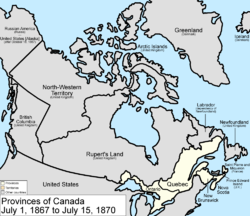| Act of Parliament | |
 | |
| Long title | An Act for enabling Her Majesty to accept a Surrender upon Terms of the Lands, Privileges, and Rights of "The Governor and Company of Adventurers of England trading into Hudson's Bay" and for admitting the same into the Dominion of Canada. |
|---|---|
| Citation | 31 & 32 Vict. c. 105 |
| Territorial extent | Rupert's Land, Canada |
| Dates | |
| Royal assent | 31 July 1868 |
| Other legislation | |
| Relates to | Deed of Surrender |


The Rupert's Land Act 1868 [1] (31 & 32 Vict. c. 105) was an Act of the Parliament of the United Kingdom of Great Britain and Ireland (as it then was), authorizing the transfer of Rupert's Land from the control of the Hudson's Bay Company to the Dominion of Canada. Often confused with the Deed of Surrender, the act is different as it only expressed that the United Kingdom and Canada permitted the transfer but did not settle on the details of exchange with HBC which were then outlined in the deed.